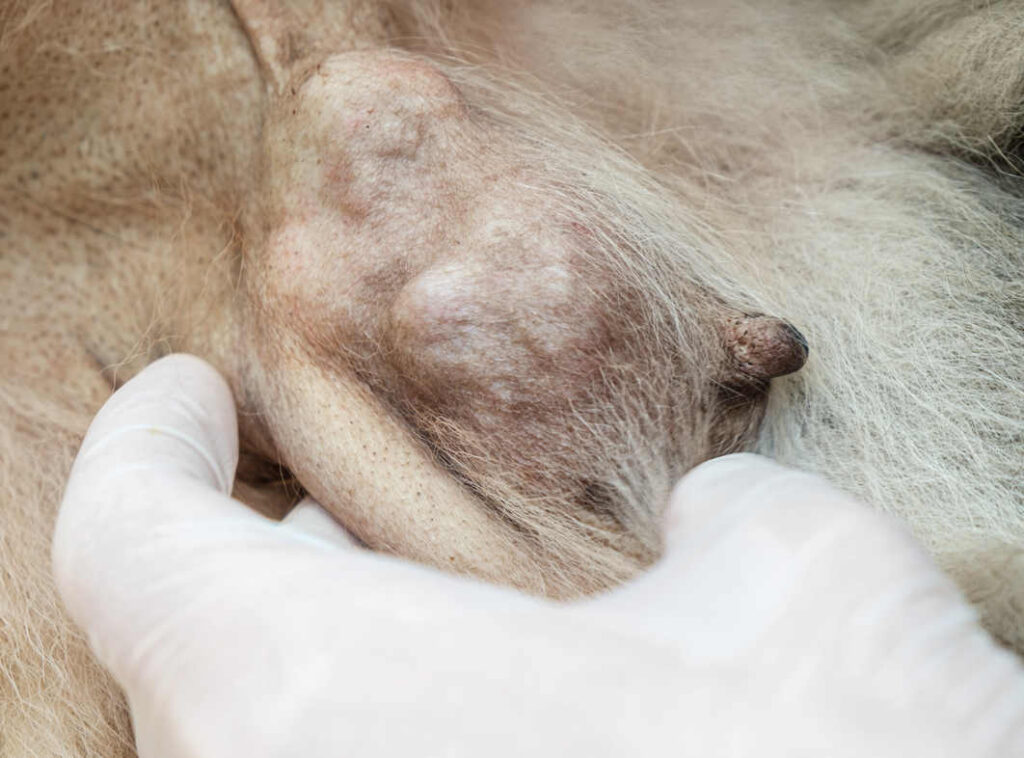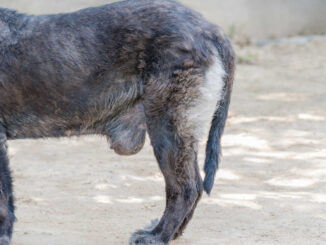
This article was updated on December 5th, 2022
Key insights:
- For benign tumors or malignant ones that haven’t yet spread, removal (without reoccurrence) is often curative. Benign tumors can be easily removed and not negatively affect life expectancy.
- Dogs with malignant tumors may live as little as one month or as long as one year or more without treatment
- Half of malignant tumors reoccur or spread to other organs. This leads to illness and a life expectancy of up to 1-2 years.
Unfortunately, dogs can develop breast or mammary cancer, and they do so at an alarming rate, especially if they’re left intact. An intact female has around a 23-34% chance of developing a mammary tumor during their lifetime. Fortunately, early detection and treatment will greatly improve a dog’s outcome. In this article, we will review treatment options and life expectancy of dogs with mammary tumors (For general information about these tumors, I recommend reading: Mammary Tumors in Dogs – With Pictures).
The life expectancy of your dog will depend on the type of tumor and treatment that can be applied. Let’s have a quick look at the types of dog mammary tumors to understand how they impact your dog’s life expectancy and quality of life.
Types of Dog Mammary Tumors
Dog mammary tumors are lumps that come from the mammary tissue along a dog’s belly. Most female dogs have five sets of mammary glands that extend from the groin to their armpits. They can develop tumors in one or more glands or in the entire mammary chain on one side.
Mammary tumors in dogs are benign about half the time and malignant about half the time. Mammary tumors in dogs may also vary in the size and shape. They may also appear as a singular lump or multiple lumps along the same side. Dogs may also have both benign and malignant tumors at the same time. The only way to tell what type of mammary tumor a dog has is with a biopsy.
Benign mammary tumors in dogs are usually small, firm and well defined. You may notice a small lump while petting your dog’s belly, as showcased on our picture below:

Malignant mammary tumors may be small, large, a single lump or multiple lumps. They often have bumpy edges and are tightly fixed to the skin or underlying tissue, as shown below:

To learn more about dog mammary tumors and view more pictures, read our article: Mammary Tumors in Dogs (With Pictures). Let’s now review treatment options and life expectancy data based on the type of tumors.
Life Expectancy of Dogs with Mammary Tumors

The life expectancy for a dog with mammary tumors is going to depend on the type of tumor, the degree of spread, and any treatment. For nearly every mammary tumor, surgical removal will be the treatment of choice. Tumor removal requires a large area to be resected and may involve removing multiple glands.
Life expectancy with benign tumors or tumors that have not spread:
For benign tumors or malignant ones that haven’t yet spread, removal is often curative: dogs with benign tumors or malignant ones that haven’t spread and are completely resected are most often cured without further treatment. Benign tumors can be easily removed and not affect life expectancy. However, keep in mind there is also a chance for reoccurrence.
Life expectancy with malignant tumors:
For tumors that have already spread, you’re looking at a discussion about quality of life and whether or not surgery is the right option. For pups with malignant tumors, consultation with a veterinary oncologist may be recommended to determine if chemotherapy or radiation should be pursued. However, there is currently not a great chemotherapy or radiation protocol for mammary cancer.
The smaller the tumor is, the more likely it will all be removed and the less chance it has of recurring and spreading. Dogs with malignant tumors should be kept on the lookout for new tumors to pop up in other mammary glands. Unfortunately, about half of malignant tumors reoccur or spread to other organs within 1-2 years (source).
- Dogs with malignant tumors may live one month or one year or more without treatment, while surgical removal without reoccurrence might be curative.
- Other dogs will have reoccurrence and even spread to other organs within 1-2 years.
Read more:
 Cost of Removing Dog Mammary Tumors [By Surgery Type and Location] - ✔️Article written by a veterinarian, and reviewed by Dr. Whittenburg, Pet Hospital Director. Mammary tumors in female dogs are extremely common. So… [...]
Cost of Removing Dog Mammary Tumors [By Surgery Type and Location] - ✔️Article written by a veterinarian, and reviewed by Dr. Whittenburg, Pet Hospital Director. Mammary tumors in female dogs are extremely common. So… [...] Rupture of a Dog Mammary Tumor: FAQ With a Veterinarian - Since dog mammary tumors make up more than 40% of all diagnosed tumors in dogs, it’s something that we deal… [...]
Rupture of a Dog Mammary Tumor: FAQ With a Veterinarian - Since dog mammary tumors make up more than 40% of all diagnosed tumors in dogs, it’s something that we deal… [...] Dr. Bonk Explains Mammary Tumors in Dogs (With Pictures) - Not only are dogs capable of developing breast or mammary cancer, but they also do so at an alarming rate,… [...]
Dr. Bonk Explains Mammary Tumors in Dogs (With Pictures) - Not only are dogs capable of developing breast or mammary cancer, but they also do so at an alarming rate,… [...]Disclaimer: This website's content is not a substitute for veterinary care. Always consult with your veterinarian for healthcare decisions. Read More.





Be the first to comment